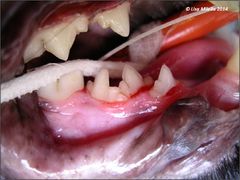Tooth Eruption Disorders
Introduction
Disorders of eruption:
- Missing teeth
- Supernumerary teeth
Abnormalities in development and eruption may occur and can cause clinical problems if not diagnosed and treated.
Missing Teeth
Congenitally missing teeth are common findings in dogs. Missing teeth may be of no functional significance to the patient, but radiographs should be taken to prevent a misdiagnosis of an unerupted or impacted tooth, which may lead to further problems, such as obstruction of the nasal passages or the development of a dentigerous cyst.
Teeth that are missing either never developed or failed to erupt. These disturbances may be inherited but may also be acquired or idiopathic. They may be congenital or may occur later during the formation of the tooth.
Teeth may be truly absent as a result of an inherited abnormality or as a result of disturbances in the formation of the tooth during the initial stages of development. A complete absence of teeth is known as anodontia, which is very rarely seen in dogs. Hypodontia, the absence of a few teeth, is relatively common in dogs and is seen in many breeds. The premolars appear to be the most commonly affected teeth. In people, anodontia has been associated with ectodermal dysplasia. This may be similar in hairless breeds which often present with missing or malformed teeth. An unerupted tooth may be unerupted due to the presence of thick fibrous gingival tissue. The teeth most commonly affected are the first premolars. A radiograph should be taken to confirm the presence of the tooth. If a tooth is present a procedure called an operculectomy (excision of gingival tissue) can be performed to allow crown exposure and further eruption of the tooth.
An impacted tooth is a tooth that has failed to erupt, as the path of eruption has been obstructed by another tooth or some other physical barrier. Occasionally it may be due to an abnormal eruption path secondary to unusual orientation of the tooth bud. This can be a result of malformation of the tooth bud or as a result of trauma to the developing tooth bud.
A dentigerous cyst is a developmental odontogenic cyst and can exhibit as missing teeth.
Supernumerary Teeth
Extra teeth may be a hereditary condition. The most commonly affected teeth are the maxillary incisors and premolars.
Extra teeth can result in overcrowding, and as a result making the area more prone to plaque accumulation and the resulting periodontal disease.
Although not strictly supernumerary teeth, persistent deciduous teeth may also cause problems. Persistent deciduous teeth is an inherited condition in certain breeds and results in the development of a malocclusion as well as plaque retention and resulting periodontitis.
| This article was written by Lisa Milella BVSc DipEVDC MRCVS. Date reviewed: 13 August 2014 |
| Endorsed by WALTHAM®, a leading authority in companion animal nutrition and wellbeing for over 50 years and the science institute for Mars Petcare. |
Error in widget FBRecommend: unable to write file /var/www/wikivet.net/extensions/Widgets/compiled_templates/wrt6962f2a82ba6c4_78209849 Error in widget google+: unable to write file /var/www/wikivet.net/extensions/Widgets/compiled_templates/wrt6962f2a834f412_35534996 Error in widget TwitterTweet: unable to write file /var/www/wikivet.net/extensions/Widgets/compiled_templates/wrt6962f2a83ac584_91379647
|
| WikiVet® Introduction - Help WikiVet - Report a Problem |



